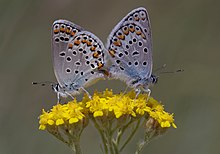You can help expand this article with text translated from the corresponding article in Russian. (April 2023) Click for important translation instructions.
|
| Kretania eurypilus | |
|---|---|

| |
| Mating pair, in Turkey. | |
| Scientific classification | |
| Domain: | Eukaryota |
| Kingdom: | Animalia |
| Phylum: | Arthropoda |
| Class: | Insecta |
| Order: | Lepidoptera |
| Family: | Lycaenidae |
| Genus: | Kretania |
| Species: | K. eurypilus |
| Binomial name | |
| Kretania eurypilus (Freyer, 1852) | |
| Synonyms | |
| |
Kretania eurypilus, the eastern brown argus, is a butterfly found in the East Palearctic (Balkans, Asia Minor, Iraq, Iran) that belongs to the family Lycaenidae.
Subspecies
- K. e. eurypilus Asia Minor, Transcaucasia, West Iran
- K. e. euaemon (Hemming, 1931) Lebanon
- K. e. iranica (Forster, 1938)
- K. e. pelopides van der Poorten, 1984 South Greece
- K. e. khorasanus ten Hagen, 2013
- K. e. afgnaniensis ten Hagen, 2013
- K. e. kuhpayensis ten Hagen, 2013
Description from Seitz
For a key to the terms used, see Glossary of entomology terms.L. eurypilus Frr. (= carmon Gerh.) (78 g, h). Much smaller than the preceding forms, very similar to argus, but male not blue above but dark brown like the female, bearing often also like this sex red-yellow marginal spots in the anal area of the hindwing . — Asia Minor, Mesopotamia, Turkestan and North Persia, on rocky slopes, from May till July. Larva probably on Astragalus echinus, as the butterfly is especially plentiful where this plant grows.
Biology
The larva feeds on Astracantha arnacanthoides, A. rumelica, A. gummifera, A. aurea, A. caucasica and is associated with the ant Camponotus kiesenwetteri.
References
- Freyer, 1852 Neuere Beiträge zur Schmetterlingskunde mit Abbildungen nach der Natur. (81-100) Neuere Beitr. Schmett.
- ^ Savela, Markku. "Kretania eurypilus". Lepidoptera and Some Other Life Forms. Retrieved August 9, 2019.
- Adalbert Seitz in Seitz, A. ed. Band 1: Abt. 1, Die Großschmetterlinge des palaearktischen Faunengebietes, Die palaearktischen Tagfalter, 1909, 379 Seiten, mit 89 kolorierten Tafeln (3470 Figuren)
 This article incorporates text from this source, which is in the public domain.
This article incorporates text from this source, which is in the public domain.
| Taxon identifiers | |
|---|---|
| Kretania eurypilus | |
| Plebejus eurypilus | |
| Polyommatus eurypilus | |